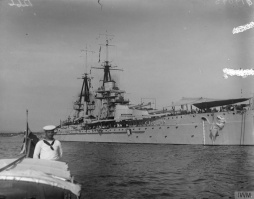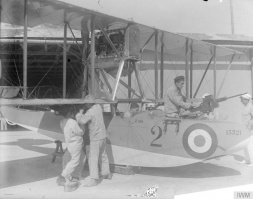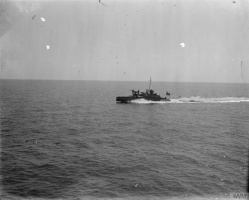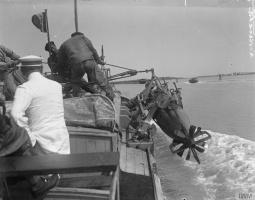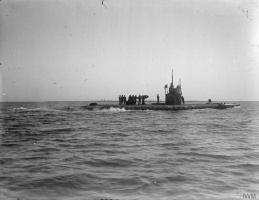The Regia Marina on the Eve of War↑
Between 1882 and 1915, the Regia Marina (Italian royal navy) faced the probability of conflict with both France and Austria-Hungary. This double threat led Italian admirals to build a large and highly mobile battle fleet, centered on fast but lightly armored battleships. The buildup of the fleet required a great expansion of the naval budget and, in 1913, the Italian navy accounted for 37.4 percent of national military expenditure: the largest proportion among the continental powers.
After the signing of the Anglo-French naval convention (1912), Italian admirals thought that the Triple Alliance naval position was unsustainable: a conflict against the Royal Navy would have meant the cutoff of all Italian seaborne trade and of communications with the African colonies. For this reason, in summer 1914, Paolo Thaon di Revel (1857-1948), chief of naval staff, pressed the government to avoid any confrontation with Britain caused by joining the First World War on Germany’s side.
In May 1915, the fleet was composed of five dreadnoughts, nine pre-dreadnoughts, eight armored cruisers, six scout cruisers, thirty-five destroyers and eighteen submarines. A large naval program of light ships, submarines and aircrafts was also under construction.
Italian naval technology suffered from the country’s poor industrial development: ships’ designs were often state of art, but lack of funds and shipyards’ limited production capacity slowed the pace of work. Then, when ships were commissioned, they were equal or slightly inferior to those of the other navies. Moreover, the Regia Marina experienced some backwardness in training and tactics in comparison to the British and French fleets.
Checkmate in the Adriatic↑
In September 1914, Revel started to plan the war against Austria-Hungary, thinking about a decisive battle in the Adriatic, aiming to destroy the enemy fleet and avenge the humiliation suffered during the 1866 naval Battle of Lissa. However, during the first year of war, the French experience in the Adriatic imposed a change of strategy. Indeed, the French fleet successfully blocked the Austrian navy in the Adriatic by locking Otranto strait, but any attempt to extend naval operations further north and near the Dalmatian coast resulted in serious danger for capital ships, often ambushed by enemy submarines.
The French difficulties led Revel to switch the operational approach to “guerriglia marittima” (naval guerrilla). Battleships were to remain at southern Adriatic bases to reinforce the Adriatic blockade, and light forces (destroyers, torpedo boats and aircrafts) were to launch naval attrition operations to weaken the enemy fleet. France and Britain granted their support and reinforcements by signing a naval convention on 10 May 1915, just before the war began.
When the war started on 24 May 1915, the fleet’s commanding officer, Admiral Amedeo di Savoia-Aosta (1873-1933), ignored Revel’s directives and planned a more aggressive approach: light forces were to clear the southern Adriatic to allow landings on the Dalmatian coast. This was to force the Austrian battleships to leave their bases, allowing the stronger Italian and French fleets to destroy them. However, Austria started an aggressive campaign of naval bombardments and raids against the Italian coasts, paralyzing the Regia Marina’s offensive. Some Italian commanders also underestimated the submarine threat until two armored cruisers (Amalfi and Garibaldi) were torpedoed by U-boats in July 1915. These losses were followed by the sinking of the battleship Brin on 27 September 1915, caused by enemy sabotage.
Austrian successes led to a “checkmate” for both sides: the Austrian battle fleet could not leave its bases, due to the Entente numerical superiority, while Franco-Italian battleships could not enter the Adriatic without being threatened by enemy U-boats. The only Italian success, during the first year of war, was the evacuation of the Serbian army from Albania, accomplished in autumn 1915. The operation, supported by the French and British navies, led to the evacuation of approximately 340,000 Serb-Italian soldiers and Austro-Hungarian prisoners.
Adriatic Guerrilla↑
After the “checkmate” both sides changed strategy. The Austrians, with the help of the German navy, concentrated their efforts on submarine operations. Meanwhile, the Italians partially took up Revel’s strategy of naval guerrilla.
On 9 April 1916, the “Inspectorate for Submarine Weapons and Naval Aviation” was established: up to the war’s end, thirty-three new submarines were put in service and eight were lost. Submarines represented 4.9 percent of all Regia Marina activity during the conflict, but they did not sink any significant targets because of lack of training and their faulty technology. Naval aviation was also expanded and 526 seaplanes and ninety-two aircraft were in service by November 1918. During the conflict, Italian naval aircraft flew 17,050 missions, and losses amounted to 114 planes and 106 men.
In October 1915, Revel was relieved from the naval staff because of conflicts with Amedeo di Savoia and moved to Venice’s naval base. There, with the support of some young officers, he started the development of MAS (anti-submarine motorboats). The first MAS operation (6-7 June 1916) was conducted against Durres harbor, where a small steamship was sunk, showing how the new weapon was capable, due to its high speed and small dimensions, to strike effectively within enemy bases during the night.
However, until the end of 1916, the Regia Marina was in a stalemate and two more battleships were lost: the dreadnought Leonardo da Vinci was sabotaged by enemy agents (2 August 1916) and the pre-dreadnought Regina Margherita sunk after striking a mine on 11 December. The lack of success led to Revel’s reappointment as chief of staff and his designation as fleet commander, replacing Amedeo di Savoia on 7 February 1917.
The Austrians also tried to react to the stalemate, by sending their best light forces to attempt the breakthrough of Otranto straits. The following battle (14-15 May 1917) was an Austrian tactical success but the Habsburg naval forces were repulsed by the intervention of a larger Italian-British squadron. The battle outcome demonstrated to the Austrians that they could not breach the blockade and discouraged further surface operation of their fleet in the southern Adriatic.
In the following year, the Regia Marina struck a series of decisive blows against the enemy fleet: on 10 December 1917, the pre-dreadnought Wien was sunk, during a MAS incursion against Trieste, and on 10 June 1918, the dreadnought Szent Istvan was also torpedoed by MAS boats. Finally, on 1 November 1918, two Italian frogmen, employing an experimental man-guided torpedo designed by themselves, destroyed the dreadnought Viribus Unitis inside Pola’s naval base.
The Submarine Threat↑
Between 1915 and 1918, the Regia Marina also had to defend Italian sea lanes. Indeed, since the spring of 1915, German U-boats had been operating against Anglo-French communications in the Mediterranean and, after May 1915, Italian shipping became prey for enemy submarines.
In December 1915, a second naval convention was signed between the Entente members, dividing the Mediterranean into eighteen patrolling areas of which four were assigned to Italians. However, the Regia Marina proved ineffective in fighting the submarine threat because it lacked effective anti-submarine technology (a problem shared by all the other navies). Moreover, another problem was the Italian admirals’ reluctance to create a unified command in the Mediterranean, thinking that this would have allowed the French to exercise influence on Adriatic operations, and eventually undermining the results of the Italian victory. Therefore, approximately 21 percent (340,466 tons) of all Italian merchant ships were lost during the first two years of conflict.
In 1917, the situation became critical: U-boat success led to major shortages of food and raw materials on the peninsula, undermining the Italian capability to sustain the war effort. The possibility of Italy’s exit from the war (especially after Caporetto) led the British and French to improve their efforts to supply the Italians. Nevertheless, merchant ships losses decreased only in winter 1917-1918, thanks to the introduction of convoys and new anti-submarine weapons (hydrophones, depth-charges, air cover). However, up to November 1918, over 880,000 tons of Italian merchant ships were sunk by enemy actions: 57.32 percent of the total available at the start of war, a percentage greater than the French (47 percent) and British (42 percent) losses.
Conclusion↑
On 3 November 1918 (armistice day on the Italian front), the total losses of the navy amounted to three battleships, two armored cruisers, one light cruiser, eight destroyers, six torpedo boats, eight submarine, two monitors, thirteen minesweepers, fifteen MAS and eleven other ships. During the conflict, one battleship, nine light cruisers, seventeen destroyers, thirty-five torpedo boats, thirty-three submarines, thirteen monitors, 193 patrol boats and minesweepers, 299 MAS and twenty-six support ships were commissioned.
The Regia Marina won its Adriatic conflict after a hard wartime transformation, during which it acquired the capability to fight effectively in that particular scenario. The defense of Mediterranean communications was less successful, mainly because of Italian concerns about coordination with the French. Finally, the navy’s evolution reflects the weaknesses and strengths of Italy’s war effort and the country’s capability to win the war by adapting and mobilizing its resources to fight a long conflict of attrition on land and sea.
Fabio De Ninno, Università degli Studi di Torino
Section Editor: Marco Mondini
Selected Bibliography
- Gabriele, Mariano: La politica navale italiana dal 1885 al 1915, Rome 1982: Ufficio storico della Marina militare.
- Halpern, Paul G.: The naval war in the Mediterranean, 1914-1918, Annapolis 1987: Naval Institute Press.
- Sondhaus, Lawrence: The Great War at sea. A naval history of the First World War, Cambridge 2014: Cambridge University Press.
- Sullivan, Brian R.: Italian warship construction and maritime strategy 1873-1915, in: O'Brien, Phillips Payson (ed.): Technology and naval combat in the twentieth century and beyond, London; Portland 2001: Frank Cass, pp. 3-21.
- Ufficio Storico della R. Marina: La Marina Italiana nella Grande Guerra, 8 volumes, Florence 1935-1942: Vallecchi Editore.





